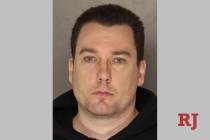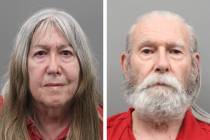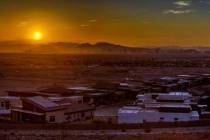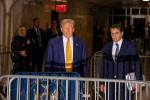Quest for quiet leads Henderson man into the wild
Fred Bell is right. After a while, you start to hear everything.
The crunch of boots on a rocky trail. The gurgle of coffee in your stomach. The plastic creak of headphones as they are pulled open and nestled over your ears.
Then everything else falls away, leaving only what Bell is really listening for: what is always there and always has been, whether we bother to hear it or not.
Bell is on a quest for quiet. The Henderson man spends his free time stalking the sounds of solitude using high-tech recording equipment he assembled himself.
“It’s not just the absence of noise,” the 53-year-old says. “I want to hear activity. I want to hear the sounds of nature.”
But what he’s after is increasingly hard to find, especially in Las Vegas.
Bell has to get up before dawn and travel to lonesome corners of Southern Nevada, almost always by himself. He has to track airline flight patterns and other noise pollution sources. He has to remain almost motionless for minutes, even hours at a time, to let nature come to him.
“It’s a lot of sitting still, being patient and failing,” he says.
Bell first started listening about six years ago, after he heard about an acoustic ecologist named Gordon Hempton, author of “One Square Inch of Silence,” an acclaimed book-turned-movement to preserve natural quiet.
As an avid outdoorsman and photographer, Bell found the idea provocative. He soon began carrying his own recorder into the mountains and the desert to capture their distinctive sounds.
“It was sort of an awakening in a way,” he says.
One of the first things he realized was that some of his favorite spots to hike and shoot pictures — places such as Red Rock Canyon and Valley of Fire — were lousy places to find quiet.
He also discovered a stark difference between what is pleasing to the eye and pleasing to the ear. He began to find great sounds to record in places he would never consider taking a photograph.
Before long, Bell came to see the distinction between quiet and silence.
“You can go places and hear absolutely nothing. There are places out at Desert (National Wildlife Refuge) where all you hear is your ears ringing and your heart beating,” he says. “I want something to listen to.”
CAPTURING QUIET
Like a lot of hobbyists, Bell started out with simple, inexpensive equipment. Now he goes into the field with several thousand dollars worth of gear, including a digital recorder wired to a pair of high-end omni-directional microphones.
The mics are carefully mounted in a special triangular box with a “foam nose” that Bell built last summer to simulate the way the human head receives and processes sound.
To shield the mics from the wind, the box is covered in furry fabric that makes it look like a long-haired gray house cat. Bell uses a tripod he made out of metal conduit to mount the box about 10 feet off the ground. Otherwise, all he gets is insect noise.
Bell’s equipment amplifies sound, so he has to be careful not to pollute his own recordings. His mics easily pick up the sound of a zipper, the click of a retractable ballpoint pen or gum being chewed. Footsteps crunch like someone chewing cereal right next to your ear. No one is going to sneak up on Bell when he has headphones on.
His recordings are filled with buzzing insects, singing birds, the flutter of wings and the soft whoosh of wind in trees. When he can, he sets up near flowing water to add gurgly depth to his soundscapes.
Early on, his recordings were only for him. After a busy day at his job as a video technician for conventions and corporate events, he would pull on a pair of headphones, kick back on the couch and let the quiet wash over him.
His hobby got a little more serious about a year ago, when he was recording sounds at Ash Meadows National Wildlife Refuge, about 90 miles west of Las Vegas, and he stopped in at the visitor center for help identifying a bird song.
Cyndi Souza, the refuge’s visitor services specialist, says she was immediately impressed by the quality and clarity of Bell’s work.
“I did not expect something so crisp and clear and with all the different sounds in it. It’s not just someone going out there with a tape recorder,” she says.
Bell now donates CDs for sale in the refuge’s small gift shop. When a new visitor center opens at Ash Meadows late this year or early next, his soundscapes will play on a continuous loop in the $8.6 million building.
He has collected about six hours of recordings for the exhibit.
Though he’s doing the work for free, he still gets up hours before sunrise so he can catch the earliest moments of what he called “the dawn chorus” at Ash Meadows once or twice a month. On his most recent trip, he left his house at 1:45 a.m. just so he could record the sound of what turned out to be a Western Kingbird, a type of migratory flycatcher that sings one way before the sun comes up then changes its tune after dawn.
SILENCE IS GOLDEN
The biggest threat to quiet is jet traffic, so Bell uses the Internet to track commercial flights and find holes on the map where few aircraft go.
His microphones will pick up an airliner long before he sees it, and it can take as much as 10 minutes for a jet to “clear the soundscape” so he can go back to recording.
“That’s why I don’t go to Valley of Fire,” he says. “It just never stops.”
Helicopters also pose a problem, particularly in areas along popular tour flight routes.
Road noise is less of a concern, he says, because it’s easier to get away from.
One of the quietest places Bell has found is Beaver Dam State Park, about 190 miles northeast of Las Vegas. On a recent four-day visit he didn’t see another person until the day he left.
Airplane noise isn’t a problem there either.
“For one six-hour recording, I think I only had to stop my recorder once,” he says.
During the trip, he captured the startled cough of a doe. Elsewhere he has caught the call and response of coyotes and chatter of squirrels chasing each other. At Great Basin National Park, 300 miles northeast of Las Vegas, he recorded the sound of a weasel sniffing his microphones.
Along the way, he has learned a few valuable tricks of the trade: Unless you want to record the sound of your own clothing, choose cotton, wool and other natural fibers over synthetic fabrics. And if you use bright red Velcro ties to secure your microphone box, don’t be surprised if all you hear is the clamor of hummingbirds at really close range.
He has also come to believe in a higher purpose for soundscape recording: the celebration and conservation of the natural world.
“I think it’s important to have quiet places,” says the married father of a teenage daughter. “I think it’s important for us to have places where we can escape.”
About three years ago, Bell made the pilgrimage to the exact spot in Washington’s Olympic National Park that inspired Hempton’s “One Square Inch of Silence.” Naturally, he took along his gear to capture the quiet there.
“It’s a rain forest. It’s serene. It’s beautiful,” he says. “But I did have two jets that morning.”
The memory bothers him a little. You can hear it in his voice.
Contact Henry Brean at hbrean@reviewjournal.com or 702-383-0350. Follow @RefriedBrean on Twitter.
Now hear this
To listen to more of Bell’s soundscapes and read about his recording project at Ash Meadows National Wildlife Refuge, go to http://ashmeadowsounds.wordpress.com/




































